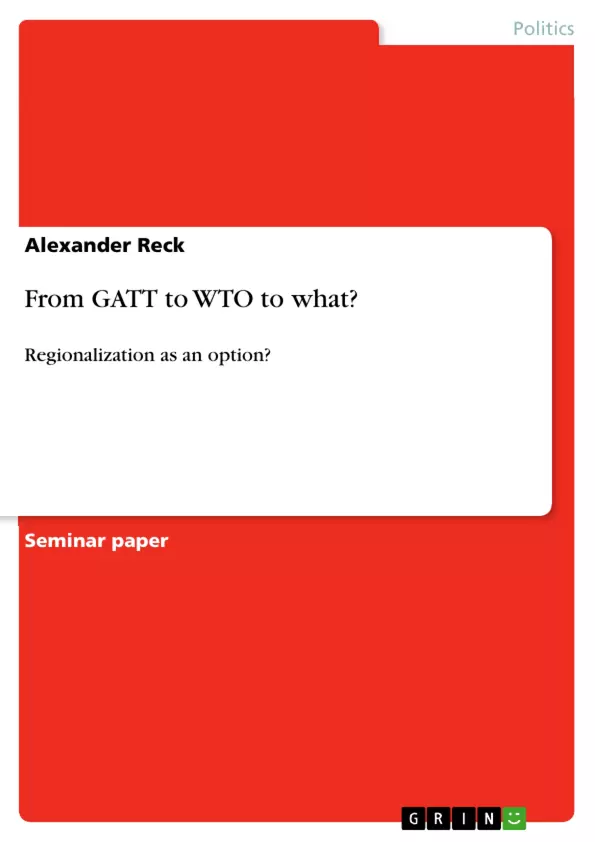Die Ursprünge und aktuelle Problemstellungen des multilateralen Handelssystems.
The multilateral trade Regime, the World Trade Organization, arrived, as
so often in its past, at a cross road. The Doha Development Agenda is now in its
7th year, once again cancelled and once again tried to be revitalized. How come?
On the one hand a broad consensus exists, saying that free trade is better for
everyone. From farmers and fishermen to bankers and C.E.O.’s, everybody from
white to blue-collar is supposed to gain welfare from global free trade. And those
who don’t even have collars can get some through trading. China’s rise in the last
decades is not imaginable without global trade. Almost 1 billion people profit
from that and that is just one country!
But on the other hand there are protectionist measures, bilateral
overreaching treaties, subsidies for bankrupt industries and non-tariff barriers to
trade installed from those countries that benefitted the most of the liberalizations
of the past decades.
Today the small ones, the former colonies, the developing countries try to
pick their piece of the pie and are not willing to let the industrialized countries
break the rules they used to engage years ago. They are not willing to take the
inequality anymore and raise their voices in one of the only forums they have,
where they’re treated on a one to one basis.
This essay will give an overview about the historic development from the
General Agreement on Tariffs and Trade to the World Trade Organization. Their
structures as well as their development will be pointed out. After exploring
libraries full of literature to the topics of GATT and WTO, the remarkable text by
Robert Winham about “The evolution of the global trade regime” appeared to be
the most comprehensive, intelligible and workable. Therefore it is one of the main
sources of this essay. Last but not least regionalization and preferentialism will be
explained in their different facets, concluding with two contrary empirical
examples for economic and political integration.
[...]
Inhaltsverzeichnis (Table of Contents)
- Introduction
- Historic Development
- From Ricardo to RTAA
- Establishing the GATT
- General Agreement on Tariffs and Trade
- Preface
- Precepts of the regime
- Prominent negotiation rounds
- Kennedy-Round and Tokyo-Round
- The Uruguay-Round
- The World Trade Organization
- Organization, Elements
- The Doha Development Agenda
- Preferentialism and Regionalization
- Types of Regional Trade Agreements
- Why RTA's?
- Regional Integration
- Empirical Evidence
- NAFTA
- EU
- Conclusion
- Annex
- Sources
Zielsetzung und Themenschwerpunkte (Objectives and Key Themes)
This essay aims to provide an overview of the historical development of the global trade regime, from the General Agreement on Tariffs and Trade (GATT) to the World Trade Organization (WTO), exploring their structures and evolution. The essay will examine the various facets of regionalization and preferentialism, concluding with two contrasting examples of economic and political integration.
- The historical development of the global trade regime from GATT to WTO.
- The structures and evolution of GATT and WTO.
- The various facets of regionalization and preferentialism.
- Economic and political integration through the lens of contrasting empirical examples.
- The role of free trade and liberalization in global economic development.
Zusammenfassung der Kapitel (Chapter Summaries)
The essay begins by examining the historical development of the global trade regime, tracing its roots back to the theories of Adam Smith and David Ricardo. The chapter discusses the rise of free trade in Great Britain during the nineteenth century, the impact of World War I on international economic cooperation, and the enactment of the Reciprocal Trade Agreements Act (RTAA) in 1934.
The essay then delves into the establishment of the GATT following World War II, highlighting the role of the United States as the dominant economic power and its influence on the Bretton Woods system. The chapter discusses the key principles of the GATT, including the Most-favored-nation (MFN) principle, and the prominent negotiation rounds that shaped its evolution.
The essay continues by exploring the World Trade Organization, examining its structure, elements, and the ongoing challenges presented by the Doha Development Agenda.
The final section of the essay focuses on preferentialism and regionalization, delving into various types of regional trade agreements and the rationale behind their formation. The chapter explores the concept of regional integration and examines two contrasting empirical examples, NAFTA and the EU, to illustrate the economic and political implications of regional trade agreements.
Schlüsselwörter (Keywords)
The essay focuses on key topics such as the historical evolution of global trade regimes, GATT, WTO, regional trade agreements, preferentialism, regional integration, NAFTA, EU, free trade, liberalization, protectionism, and the economic and political implications of these concepts.
- Citation du texte
- Alexander Reck (Auteur), 2008, From GATT to WTO to what? , Munich, GRIN Verlag, https://www.grin.com/document/144369



